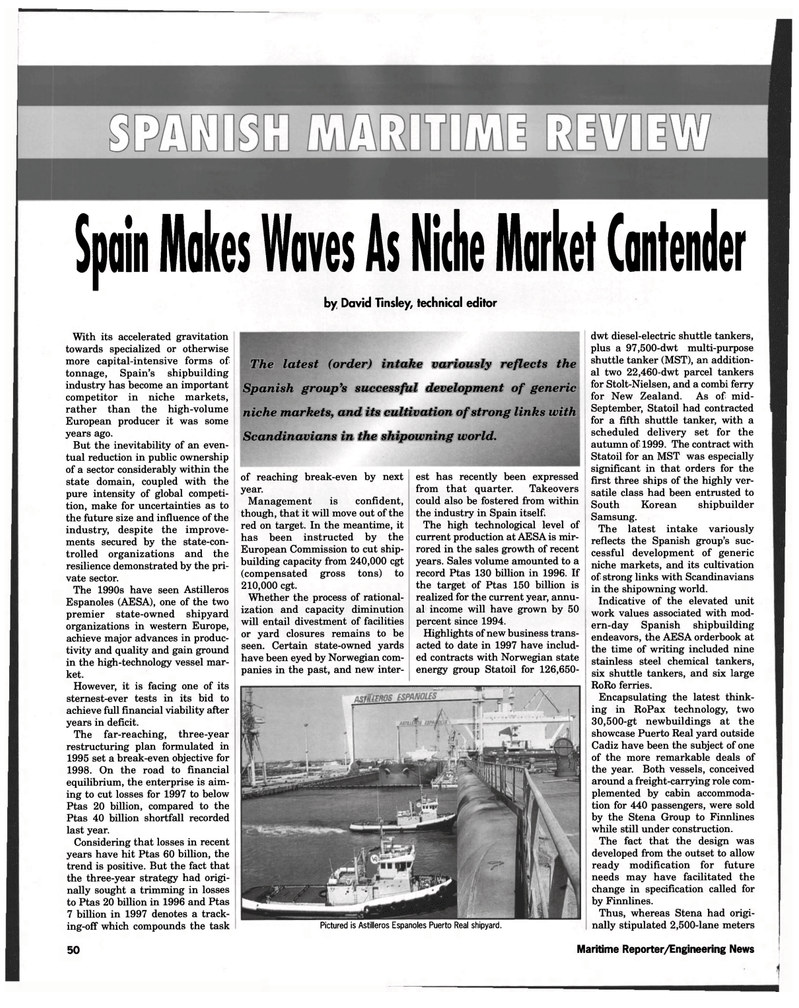
Page 48: of Maritime Reporter Magazine (October 1997)
Read this page in Pdf, Flash or Html5 edition of October 1997 Maritime Reporter Magazine
Spain Mob Waves is Niche Market Contender by David Tinsley, technical editor
With its accelerated gravitation towards specialized or otherwise more capital-intensive forms of tonnage, Spain's shipbuilding industry has become an important competitor in niche markets, rather than the high-volume
European producer it was some years ago.
But the inevitability of an even- tual reduction in public ownership of a sector considerably within the state domain, coupled with the pure intensity of global competi- tion, make for uncertainties as to the future size and influence of the industry, despite the improve- ments secured by the state-con- trolled organizations and the resilience demonstrated by the pri- vate sector.
The 1990s have seen Astilleros
Espanoles (AESA), one of the two premier state-owned shipyard organizations in western Europe, achieve major advances in produc- tivity and quality and gain ground in the high-technology vessel mar- ket.
However, it is facing one of its sternest-ever tests in its bid to achieve full financial viability after years in deficit.
The far-reaching, three-year restructuring plan formulated in 1995 set a break-even objective for 1998. On the road to financial equilibrium, the enterprise is aim- ing to cut losses for 1997 to below
Ptas 20 billion, compared to the
Ptas 40 billion shortfall recorded last year.
Considering that losses in recent years have hit Ptas 60 billion, the trend is positive. But the fact that the three-year strategy had origi- nally sought a trimming in losses to Ptas 20 billion in 1996 and Ptas 7 billion in 1997 denotes a track- ing-off which compounds the task
The latest (order) intake variously reflects the
Spanish group's successful development of generic niche markets, and its cultivation of strong links with
Scandinavians in the shipowning world. of reaching break-even by next year.
Management is confident, though, that it will move out of the red on target. In the meantime, it has been instructed by the
European Commission to cut ship- building capacity from 240,000 cgt (compensated gross tons) to 210,000 cgt.
Whether the process of rational- ization and capacity diminution will entail divestment of facilities or yard closures remains to be seen. Certain state-owned yards have been eyed by Norwegian com- panies in the past, and new inter- est has recently been expressed from that quarter. Takeovers could also be fostered from within the industry in Spain itself.
The high technological level of current production at AESA is mir- rored in the sales growth of recent years. Sales volume amounted to a record Ptas 130 billion in 1996. If the target of Ptas 150 billion is realized for the current year, annu- al income will have grown by 50 percent since 1994.
Highlights of new business trans- acted to date in 1997 have includ- ed contracts with Norwegian state energy group Statoil for 126,650-
Pictured is Astilleros Espanoles Puerto Real shipyard. dwt diesel-electric shuttle tankers, plus a 97,500-dwt multi-purpose shuttle tanker (MST), an addition- al two 22,460-dwt parcel tankers for Stolt-Nielsen, and a combi ferry for New Zealand. As of mid-
September, Statoil had contracted for a fifth shuttle tanker, with a scheduled delivery set for the autumn of 1999. The contract with
Statoil for an MST was especially significant in that orders for the first three ships of the highly ver- satile class had been entrusted to
South Korean shipbuilder
Samsung.
The latest intake variously reflects the Spanish group's suc- cessful development of generic niche markets, and its cultivation of strong links with Scandinavians in the shipowning world.
Indicative of the elevated unit work values associated with mod- ern-day Spanish shipbuilding endeavors, the AESA orderbook at the time of writing included nine stainless steel chemical tankers, six shuttle tankers, and six large
RoRo ferries.
Encapsulating the latest think- ing in RoPax technology, two 30,500-gt newbuildings at the showcase Puerto Real yard outside
Cadiz have been the subject of one of the more remarkable deals of the year. Both vessels, conceived around a freight-carrying role com- plemented by cabin accommoda- tion for 440 passengers, were sold by the Stena Group to Finnlines while still under construction.
The fact that the design was developed from the outset to allow ready modification for future needs may have facilitated the change in specification called for by Finnlines.
Thus, whereas Stena had origi- nally stipulated 2,500-lane meters 50 Maritime Reporter/Engineering News

 47
47

 49
49
